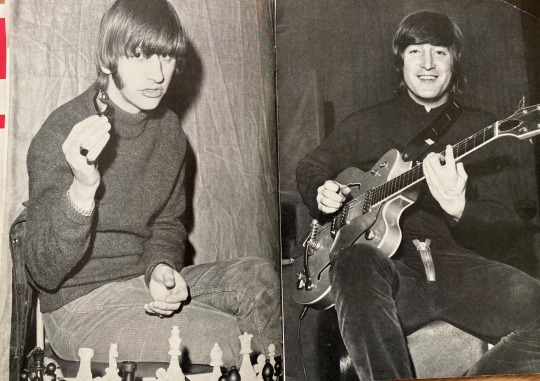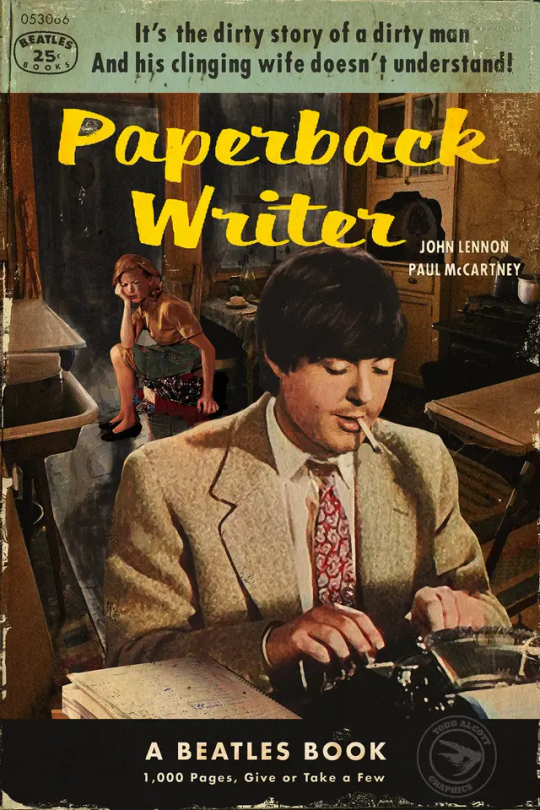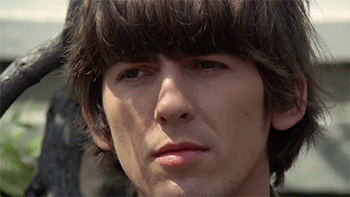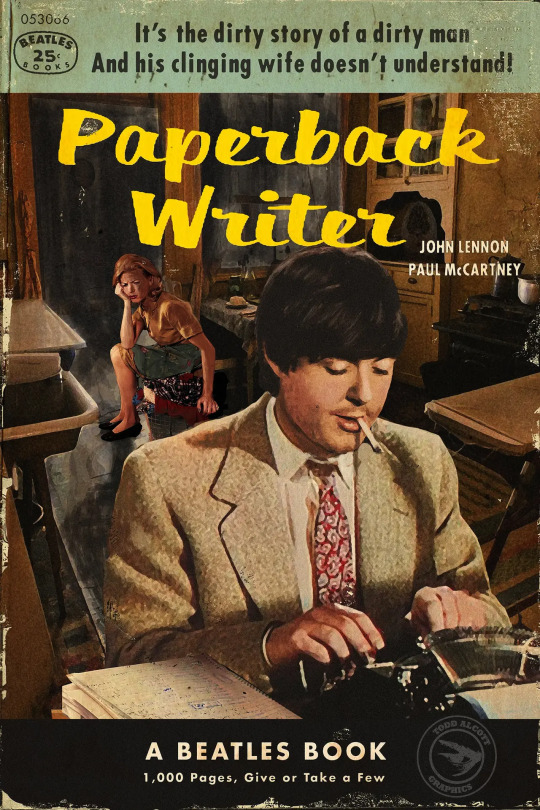#Paperback Writer
Explore tagged Tumblr posts
Text










Paul McCartney and John Lennon during the filming of the promotional videos of Paperback Writer and Rain. May 20, 1966.
#paul mccartney#the beatles#john lennon#mclennon#paul and john#lennon mccartney#beatlemania#1960s#paperback writer#1966#paulie <333#johnny <333
260 notes
·
View notes
Text




The Beatles, Paperback Writer, 1966
116 notes
·
View notes
Text

By Todd Alcott
#Todd Alcott#The Beatles#paperback writer#1965#pulp art#pulp fiction#mashup#illustration#Paul Mccartney#Beatles
186 notes
·
View notes
Text
Where's John on Revolver?
First some raw details about Revolver.
Then a question: What's up with John?
Painting testimonial pictures...
Here's the personnel list (a.k.a. ‘who plays what’) on every song from the Revolver sessions, including the non-album single “Paperback Writer”/“Rain”.
Whereas the songs were released in a certain order, a chronological reading is more revealing:
Tomorrow Never Knows John Lennon: vocals, organ, tape loops Paul McCartney: lead guitar, bass guitar, tape loops George Harrison: guitar, sitar, tambura, tape loops Ringo Starr: drums, tambourine, tape loops George Martin: piano
Got To Get You Into My Life Paul McCartney: vocals, bass John Lennon: rhythm guitar George Harrison: lead guitar Ringo Starr: drums, tambourine George Martin: organ Session musicians: horns
Love You To George Harrison: vocals, acoustic guitar, electric guitar, sitar Paul McCartney: backing vocals, tambura Ringo Starr: tambourine Anil Bhagwat: tabla
Paperback Writer Paul McCartney: vocals, lead guitar, bass guitar John Lennon: backing vocals, tambourine George Harrison: backing vocals, rhythm guitar Ringo Starr: drums
Rain John Lennon: vocals, guitar Paul McCartney: backing vocals, bass guitar, guitar George Harrison: backing vocals Ringo Starr: drums, tambourine
Doctor Robert John Lennon: vocals, rhythm guitar, harmonium Paul McCartney: backing vocals, bass George Harrison: backing vocals, lead guitar, maracas Ringo Starr: drums
Taxman George Harrison: vocals, lead guitar John Lennon: backing vocals Paul McCartney: backing vocals, lead guitar, bass Ringo Starr: drums, tambourine, cowbell
And Your Bird Can Sing John Lennon: vocals, rhythm guitar, handclaps Paul McCartney: backing vocals, lead guitar, bass, handclaps George Harrison: backing vocals, lead guitar, handclaps Ringo Starr: drums, tambourine, handclaps
I'm Only Sleeping John Lennon: vocals, acoustic rhythm guitar Paul McCartney: backing vocals, bass George Harrison: backing vocals, lead guitar Ringo Starr: drums
Eleanor Rigby Paul McCartney: vocals John Lennon: harmony vocals George Harrison: harmony vocals Session musicians: strings
For No One Paul McCartney: vocals, bass, piano, clavichord Ringo Starr: drums, tambourine, maracas Alan Civil: horn
Yellow Submarine Ringo Starr: vocals, drums John Lennon: backing vocals, acoustic guitar Paul McCartney: backing vocals, bass George Harrison: backing vocals, tambourine Mal Evans: backing vocals, bass drum
I Want To Tell You George Harrison: lead vocals, lead guitar, handclaps John Lennon: backing vocals, tambourine, handclaps Paul McCartney: backing vocals, bass, piano, handclaps Ringo Starr: drums, maracas, handclaps
Good Day Sunshine Paul McCartney: vocals, piano, handclaps John Lennon: backing vocals, tambourine, handclaps George Harrison: backing vocals, bass guitar, handclaps Ringo Starr: drums, handclaps George Martin: piano
Here, There and Everywhere Paul McCartney: vocals, acoustic guitar, bass, finger clicks John Lennon: backing vocals, finger clicks George Harrison: backing vocals, lead guitar, finger clicks Ringo Starr: drums, finger clicks
She Said She Said John Lennon: vocals, rhythm guitar, Hammond organ George Harrison: backing vocals, lead guitar Paul McCartney: bass guitar Ringo Starr: drums, shaker
(Apologies to the session musicians for glossing your names. We love you.)
What's it all about?!
Although still touring and releasing records as the original quartet of rhythm guitar / bass / lead guitar / drums, in the studio The Beatles have taken on increasingly irregular musical roles for over a year, ever since the beginning of the Help! sessions when Paul dubbed lead guitar onto “Ticket To Ride”, John played organ on “The Night Before”, and George played only guiro on “Tell Me What You See”. By summertime, John and Paul had dubbed keyboards onto various tracks; John and Paul and George were together on three acoustic guitars for “I've Just Seen A Face”; and Paul played solo acoustic guitar (with no involvement from the rest of the band) on “Yesterday”.
During Rubber Soul, they started to consciously break out of those specific musical roles from the beginning. George swapped guitar for sitar on “Norwegian Wood”, John a funky piano on “Drive My Car”, and Paul a spritely gospel stride on “The Word”; George a tambourine on “We Can Work It Out”, John an organ on “Think For Yourself, Paul an acoustic guitar on “Michelle”. John sang backups with no instrument on “You Won't See Me”. Paul was so far as adding electric guitar to “Drive My Car” and drums to “You Won't See Me”, to his bandmates’ annoyance. Nonetheless, despite these irregularities, The Beatles retained their “traditional” roles way more often than not.
Revolver is the first Beatles album in which the irregular becomes the new norm. Without completely abandoning their former posts, they experiment with new and different musical roles to varying degrees:
Ringo still plays drums, of course, though a pinch less than before. He appears on 15 of the sixteen tracks (which was also the case for Help!) — playing drums on 14 songs, tambourine on one, and absent entirely from one.
Paul still plays bass mainly, but somewhat less than before. He appears on all 16 tracks — the only Beatle who's on everything (which has been the case on every Beatles album so far) — playing bass on 13 songs, piano on three, guitar on six (electric on five, acoustic on one), even tamboura on one, and nothing but lead vocal on one — aside from ornamental handclaps and backing vocals throughout.
George is also still playing guitar mostly, but also gets somewhat less action than before. He also appears on 15 of the sixteen tracks (which was the case for him on two prior albums) — playing guitar on 11 songs (as well as sitar on two on those), bass on one, tambourine on one, nothing but backing vocals on two, and absent entirely from one — in addition to handclaps and backing vocals.
John, however, is an anomaly. Despite occasionally playing his timid guitar with temerity, John tenaciously neglects it more often than not. He appears on 14 of the sixteen tracks — the least of any Beatle on this or any album to date — playing guitar on a mere 7 songs (electric on five, acoustic on two), organ on one, tambourine on three, fingersnaps on one, nothing but backing vocals on two (like George), and absent entirely from two.
(Not that there's a direct correlation here, but John's retreat from playing his usual instruments happens to coincide with George's emergence as a viable third songwriter in the group.)
All together now...
Revolver (plus the single) has 13 songs on which all four Beatles perform — either playing, singing, or both. Of the remaining three songs: “Love You To” contains three members (minus John); “For No One” contains only two members (Paul and Ringo); and “Eleanor Rigby” contains none of the Beatles playing instruments, only their vocals (minus Ringo).
But they're all there in some way or another. When John's not playing, at least he still sings. (That's an easy gig.) Or sometimes shakes a tambourine. Same for George.
Not a big deal if somebody lays out for one, they're all in there most of the time. It's still The Beatles.
It sounds like The Beatles.
It's all in the mind...
Because people identify The Beatles as being two guitars, bass and drums, plus three vocalists, they expect to hear those instruments, and they mentally identify each instrument (or voice) with a corresponding player, even though they can't see the person playing or singing. So as long as a Beatle track contains evidence of two guitars, bass, drums, and multiple voices, who actually plays or sings is irrelevant, and the listener will be satisfied that this is indeed those four guys playing their instruments and singing a lovely song. (This has been the case for a long time — ever since 1963, the Beatles have exploited that perception by double-tracking their vocals.)
Nothing is real.
Even the single — “Paperback Writer” and its b-side “Rain” — only gives the illusion that The Beatles are playing. On the former, Paul and George handle guitars while John shakes a tambourine; and on the latter, John and Paul handle guitars while George lays out entirely. Only their combined vocal contributions make these tracks Beatle performances, even if they're not actually playing all together now in their standard concert lineup.
In fact, nearly three-quarters of the songs (11 in all) contain the combined voices of John and Paul and George (one of which features Ringo on lead), and 2 more contain a backing vocal from at least one of the others who's not singing the lead. Only three songs lack any sort of backing or harmony vocal. The sessions really are a group effort in that regard.
However, if one were to discount backing vocals, and also subtract the tambourine (which honestly any of them could have played equally well) — taking into account only the songs on which all four Beatles actually play instruments ... they only play together on 6 songs!!
Four of these songs feature the band playing all their traditional instruments — only four songs on the whole album!!
“I'm Only Sleeping” “She Said She Said” “And Your Bird Can Sing” “Doctor Robert”
All John songs.
Then there's Paul's song “Got To Get You Into My Life” — a special case since technically all four of them are playing, except that the guitars are mixed out for the majority of the song and replaced by horns copying those same guitar lines. (This is the only Paul song on Revolver on which they all play.)
“Tomorrow Never Knows” is another special case of the full band playing, albeit in a highly irregular formation. Paul and Ringo hang onto their usual bass and drums, whereas the guitarists split off onto sitar (George) and organ (John). The copious tape loops (a true group effort) and backwards guitar take centre stage atop the instrumental bed, and in the end it's a true Beatles track ... just not in any traditional sense ... which (paradoxically) is part of what makes it so quintessentially Beatles. It was the culmination of a few years of gradual experimentation, and it galvanised the way they would work from that point forth.
So, with all that said: what's up with John?
🍏
#the beatles#john lennon#paul mccartney#george harrison#ringostarr#paulmccartney#georgeharrison#george martin#brian epstein#beatles fandom#revolver#paperback writer#rain#taxman#eleanor rigby#here there and everywhere#yellow submarine#for no one#tomorrow never knows#ringo starr#beatlemania#beatles#abbey road
35 notes
·
View notes
Text


paperback writer beatlesona is born and he’s day tripper’s little brother
86 notes
·
View notes
Text
The Beatles - “Paperback Writer”
#the Beatles#paperback writer#music#love#indie#pop#underground#rocknroll#spotify#art#song#60s music#john lennon#paul mccartney#george harrison#ringo starr
35 notes
·
View notes
Text

#carl corley#vintage art#paperback writer#paperback art#gay author#gay fantasy art#gay artists#gayart#gay art#gay fantasy#newblvotg#gay#queer#lgbtq#art
23 notes
·
View notes
Text
The Beatles Hits Tourney
- Round 2 Group 3 Poll 4
Paperback Writer by the Beatles
youtube
Hot 100 Peak Position: 1
Peak Date: June 25, 1966
And I Love Her by the Beatles
youtube
Hot 100 Peak Position: 12
Peak Date: September 5, 1964
Please listen to each song before voting!
#the beatles#paul mccartney#john lennon#george harrison#ringo starr#music#pop#rock#1960s#and i love her#paperback writer#poll#polls#tumblr polls#tumblr poll#Youtube
9 notes
·
View notes
Text

21 notes
·
View notes
Text
“To the best of our ability Paul!”: The Paperback Writer session [and fashion show]
By Johnny Dean. From: The Beatles Book Monthly, Issue 35. June 1966.
As we walked down the corridor towards E.M.I.’s No. 2 studio (where else would one go when sitting-in on a Beatles recording session), the commissionaire pointed out to us that the boys were in No. 3 instead. So we made our way back to the front of the building and as we approached the studio door, the red light went on—which meant that they were recording. So we waited for them to finish. Three minutes later we walked in.
On entering the studio, we found John and Paul surrounded by a mass of equipment—most significant of all, were their new massive amplifiers. Paul was clad in his distinctive casual recording gear of black trousers, black moccasin-type shoes, white shirt with fawn stripes, a black sleeveless pullover and to top it all orange—tinted specs. John sported green velvet trousers, a blue buttoned up wool vest and black suede boots.
The basic track of "Paperback Writer" had been recorded the previous day, and now John and Paul were working out a detailed backing. Paul was perched on a stool thumbing away at a red and white Rickenbacker guitar, (moving with the music as he does on stage) whilst the Iyrics boomed through the studio speakers—so we were very honoured at being the first to hear their new single besides George Martin and of course, the Beatles.
We then spotted Ringo's head behind the screen in the far corner—he was playing chess with Neil. So we walked over. "Who's winning?", I asked. "Neil's the expert”, Ringo replied, and went back to the chess board to concentrate on how to get his king out of danger from an attack by Neil's bishop and castle.
The music stopped. George Martin came into the studio from the control room to have a tete-a-tete with Paul as to what they could do to improve the backing.
"What are you trying to do with this one?", I asked Paul. "Have you heard the lyrics?", came the reply. "Yes, I think it's very unusual”. "The trouble is", said Paul,"That we've done everything we can with four people, so it's always a problem to ring the changes and make it sound different. That's why we have got all these guitars and equipment here." That must have been the understatement of the year, because the studio was littered with pianos, grand pianos, amplifiers, guitars, percussion instruments, and other odd bits and pieces which were strewn over the studio floor.
The studio was sectioned-off with brown canvas screens and what seemed like thousands of black cables running from the amps and other electrical equipment to the control room over the heavily marked wooden floor. To stop the echo, E.M.I. have covered some of the floor with old carpets.
The big heavy sound-proof door which stops any of the noise of the outside world seeping into the studio, burst open, and in strolled George looking very elegant in his Mongolian lamb fur coat with black cap and oblong metal specs.
He was obviously on top of the world and bubbling over with enthusiasm, ready to record a dozen numbers. He threw his coat along side Paul's fur jacket and got down to work out the backing with John and Paul.
John, George and George Martin huddled round Paul, who was seated at the piano trying to work out a bass bit, before asking George Martin to play it. John leaned on the piano while he listened to Paul's ideas for a while. Then he picked up his orange Gretsch guitar and proceeded to pick away at it. At the same time Paul transferred to a Vox organ.
Although John and Paul were both working on the song together, it was originally Paul's idea. He asked the engineer to play it back at half speed so that John and George could do some vocal bits.
They were now all set to go. George Martin gave the O.K. The recording light went on and the basic sound track was played back through the "cans" they each had clamped over their heads. They did several takes. John and George hit some very high notes, but their voices kept cracking. "I don't think I can make it" said George, "unless I have a cup of tea. Where’s Mal?”
Right on cue at the end of the fourth take Mal emerged into the studio laden with tea, biscuits and something very special—toast and strawberry jam. Everything was immediately dropped and a sudden swoop was made on the toast and jam. Ringo, who was still in the corner trying to work out his next move, only got one piece of toast, so Mal offered to make another batch as it had proved so popular.
Meanwhile Beatles Book photographer Leslie Bryce was clicking away.
After the toast and jam had been devoured it was back to work. Paul suddenly got an inspiration he dived across to the piano and started playing bits of "Free Jacques" he was highly delighted at the thought of having it in the new single.
"O.K. let's try it", said George Martin. So John and George gathered round the mike and off they went. But it was a false start. Paul's head appeared over the top of the piano and he queried "Did you come in at the right place?". "We can't hear it properly" , said John, "anyway I thought that was the end of it.” George promptly told him it was the beginning!
After they had finished taping these bits, the tracks were played back into the studio while everyone listened in silence. George Martin was the first to speak-"I think that the best thing we've added are the 'Frere Jacques’ bits. Ringo who had finally beaten Neil at a game of chess by check-mating him in several brilliant moves involving a queen, a bishop and a castle, said that he thought John and Paul sounded as though they were singing through water! Highly uncomplimentary, so Paul then made for the organ once again and started to work out a sound which resembled that of Scottish bag pipes.
John then came swooping across the studio and shouted out—“You've got it. You've got it". Paul then started dum-dee-dumming away at everyone else—it was just like a scene from "My Fair Lady”!
George Martin appeared over John's shoulder and said "I see what you mean”. Paul announced that someone else should play it—meaning George Martin. John and George then went back to their mikes and added the vocals over the top.
After the first track Paul looked over the top of the piano and asked John and George if they were singing it right.
George turned round, lowered his glasses to the tip of his nose and looked down at Paul in a typical school-masterish fashion and said "To the best of our ability Paul!" And so the boys went on getting the sound that you will hear on "Paperback Writer”.
It was a long session. It took something like ten hours to record because the Beatles insisted on sticking at it until they were completely satisfied that they can do no more.
When you listen to "Paperback Writer" bear in mind what went on beforehand to achieve this really great sound, and I'm sure you'll appreciate it all the more.

"The very first shot of Paul we took when we arrived in the studio." (Photo by Leslie Bryce)

"Paul's hit on something. Waving his 'ciggie' he dee-dums his way through the bit he's just thought up while George sings with him." (Photo by Leslie Bryce)

Ringo's chess pieces and John's green velvet trousers. (Photos by Leslie Bryce)
#the beatles#george martin#paul mccartney#john lennon#george harrison#ringo starr#mal evans#paperback writer#lots to unpack#lots to unzip#George had so much more fun here than in Get Back#Paul and George Martin comma huddling#amazing creative energy#ten hours
133 notes
·
View notes
Text
youtube
The Beatles - Paperback Writer
#the beatles#paul mccartney#george harrison#ringo starr#john lennon#paperback writer#revolver#Youtube
14 notes
·
View notes
Text

101 notes
·
View notes
Text
Paperback Writer
The Beatles’ 1966 single “Paperback Writer” is noteworthy for —
Its new driving sound...
Its surreal storytelling...
Its unprecedented international success...
Its lackluster domestic sales...
Serving as a harbinger of Revolver...
Providing the musical matrix for The Monkees...
Its deeper connection to a through-line (one of many) in The Beatles Story.
Painting testimonial pictures....
It's a guitar riff nasty enough to take the paint off the wall — yet played so fluidly and melodically that it almost sounds baroque in its articulation.
Add to that the newfound thickness of the drums and stunningly deep bass tone (courtesy of copious company rule-breaking by new chief engineer Geoff Emerick and his accomplice assistant engineer Ken Townsend).
But what really drives “Paperback Writer” is how the lyric gives the appearance of a cover letter from an aspiring novelist pitching the treatment for their new novel. Layers upon layers. Who does that? It's mad! And also short and to the point, so it doesn't ever become tedious. Like an ideal cover letter!
What's it all about?!
After its release the single went #1 in twelve countries (includo UK and US), the most simultaneous #1's of any artist ever perhaps. Maybe not, but certainly in the top three, and definitely the most of any band ever.
Despite topping the charts at home once again, domestic sales were apparently the most sluggish of any Beatles record since “Love Me Do”. Curious.
Nonetheless, in the mass consciousness it served to bridge the musical space between the sounds of Rubber Soul echoing through the spring of 1966, and the opening strains of “Taxman” that would inaugurate the musical cornucopia of Revolver later that summer.
The deeper you go....
In essence “Paperback Writer” was Paul's subtle plug for his girlfriend's brother's new boutique bookshop, and books and reading in general.
Completely incidentally, “Paperback Writer” also represents exactly one half of the template for “Last Train To Clarksville”, the made-to-order Boyce/Hart composition to be released a few months later as the debut single for the made-for-American-TV Beatles knock-off series The Monkees. The other half of that template is the final track on Rubber Soul, “Run For Your Life”. Along with the entirety of Rubber Soul and the forthcoming Revolver albums, “Paperback Writer” and its b-side constitute the core matrix of The Monkees sound that would emerge over the next two years across six albums and as many singles.
And in the end...
Deeper still, the most magical element of “Paperback Writer” is the much larger story surrounding it — involving Pink Floyd, Peter and Gordon, Marianne Faithful, Yoko Ono, and The Beatles themselves — a story that centres around one Indica Bookstore (and Gallery) in St. James, London...
🍏
#indica#the beatles#paul mccartney#john lennon#george harrison#ringo starr#george martin#brian epstein#beatles fandom#peter asher#john dunbar#barry miles#paperback writer#rain#rubber soul#revolver
21 notes
·
View notes
Text

The Beatles - Paperback Writer (1966)
#paperback writer#the beatles#george harrison#john lennon#ringo starr#paul mccartney#1966#60s aesthetic#gif
98 notes
·
View notes
Text
Paperback Writer - The Beatles
youtube
16 notes
·
View notes
Text

Todd Alcott Graphics
18 notes
·
View notes